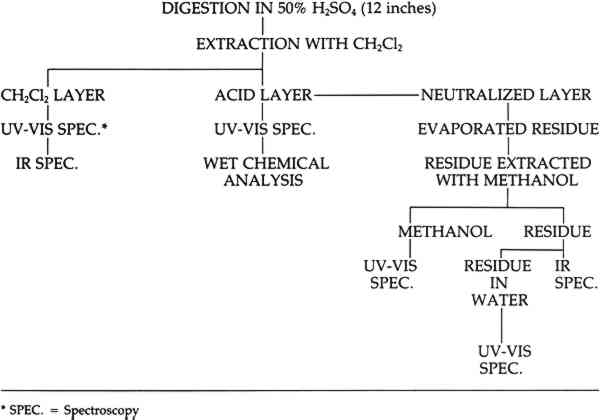BLUE DYE IDENTIFICATION ON CELLULOSIC FIBERS: INDIGO, LOGWOOD, AND PRUSSIAN BLUEAnn Cordy, & Kwan-nan Yeh
2 EXPERIMENTAL2.1 MaterialsTwo-ply, s-twist, wet-spun flax thread obtained from a commercial source was scoured and bleached prior to dyeing by nineteenth-century methods. These materials were selected after analysis of the original sewing thread indicated a flax thread of this type.3 Natural indigo and logwood were obtained from commercial sources. Prussian blue was produced on the fiber. All other chemicals used for pre-dye thread preparation and analysis of dyes were reagent-grade laboratory chemicals. Steps and chemicals involved in both pre-dye thread preparation and dyeing are reported elsewhere.4 2.2 Aging ProceduresThe artificially aged samples were prepared by subjecting undyed flax thread and thread that had been dyed as above to light and heat under atmospheric conditions. This accelerated aging with light and heat was chosen to approximate the aging conditions of the nineteenth-century sewing thread. Aging was purposely severe to Lightfastness testing was done using an Atlas Fadeometer with a carbon-arc lamp. Relative humidity was kept at 32 to 36%. The dry bulb temperature was maintained at 124 to 127�F. Color was noted at ten to twenty hour intervals. Testing was stopped at 215.75 hours when the thread showed signs of brittleness. Heat-aging was done in a forced-air oven maintained at 148�C. Skeins of about 0.2 grams of dyed and undyed thread were hung from the oven rack without touching any metal surfaces or each other. The maximum time in the oven was 254 hours when thread brittleness occurred. 2.3 Analytical ProceduresThe analysis techniques were designed to make maximum use of limited sample size and for discrimination among the three blue dyes. The overall flow chart is presented in Figure 1. A 50% sulfuric acid solution was used to digest the flax thread within one to two hours without destroying the dyes.
2.3.1 Ultraviolet-Visible Spectroscopy (UV-VIS).UV-VIS analysis was done with a Beckman Model 25 Spectrophotometer with a Beckman Recorder. The methylene chloride layer of acid-digested aged and non-aged dyed flax thread was analyzed with UV-VIS spectroscopy. 2.3.2 Infrared Spectroscopy (IR).Samples were run on a Perkin Elmer Infrared Spectrophotometer (#281-B) with an interfaced data station. The methylene chloride extraction layer was analyzed by IR. 2.3.3 Wet Chemical Analysis.The aqueous layer from the digested samples was examined for ferricyanide and ferrocyanide ions of Prussian blue. The addition of iron salts to solutions containing ferricyanide or ferrocyanide ions gives a dark blue precipitate.5 |
